How To Maintain Your Bike
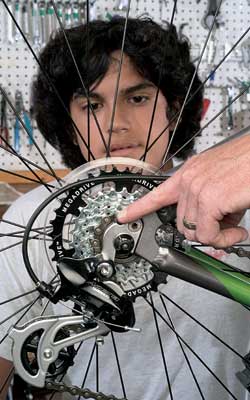 We cyclists really ask a lot of our bikes. We ask them to carry us over miles of roads or trails and then to get us back home safely. We depend on our tires to provide a cushion between the bike’s frame and the ground. We depend on our chain to turn the wheels and shift the gears. And we depend on our brakes to stop us whenever we squeeze them. With so much riding on your bike, you wouldn’t dare neglect it between rides, would you? Failure to maintain proper tire pressure can result in a flat. Failure to maintain your brakes can result in something much worse.
We cyclists really ask a lot of our bikes. We ask them to carry us over miles of roads or trails and then to get us back home safely. We depend on our tires to provide a cushion between the bike’s frame and the ground. We depend on our chain to turn the wheels and shift the gears. And we depend on our brakes to stop us whenever we squeeze them. With so much riding on your bike, you wouldn’t dare neglect it between rides, would you? Failure to maintain proper tire pressure can result in a flat. Failure to maintain your brakes can result in something much worse.
There are plenty of reasons to take good care of your bike, and you don’t have to be a professional technician to do it. Richardson Bike Mart, in Richardson, Tex., is the shop that sponsors the Matrix Cycle Club, which gave a little-known biker named Lance Armstrong a boost early in his biking career when he joined the team in 1987. Now, the experts there will give you a boost, too. Just a few tools and the know-how on the following pages will get you off to a great start in maintaining your bike. Then you can ride confidently, knowing that your set of wheels will come through when you need them most.
CHANGING A FLAT TIRE
Ken “Woody” Smith, the general manager of one of Richardson Bike Mart’s Dallas-area stores, says most repair work he does is fixing tires damaged from riding with low air pressure. Get in the habit of checking your tire pressure once every 7 to 10 days, whether you’ve ridden your bike during that time or not. And “checking your tire pressure” doesn’t just mean squeezing the tires with your fingers and guessing how much air is in there. It means connecting a pressure gauge to the tire to get an accurate reading. But sometimes, flats just happen. A nail in the road or a sharp rock on the trail can create the need for a new inner tube, or in some cases, a whole new tire. Here’s how to remove your tires and fix a leak:
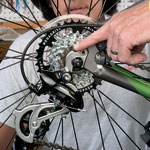 Step 1. Start with the back tire (the most difficult to remove). Shift the chain to the smallest sprocket (the highest gear). If you ride a bike without multiple gears, use a wrench to loosen the nuts and remove the chain from the sprocket.
Step 1. Start with the back tire (the most difficult to remove). Shift the chain to the smallest sprocket (the highest gear). If you ride a bike without multiple gears, use a wrench to loosen the nuts and remove the chain from the sprocket.
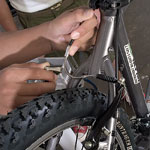 Step 2. Unhook the brake by pulling the noodle (the part that connects the left and right brakes) to the side and unhooking the brake-release mechanism.
Step 2. Unhook the brake by pulling the noodle (the part that connects the left and right brakes) to the side and unhooking the brake-release mechanism.
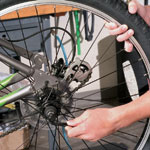 Step 3. To remove the tire, pull the quick-release lever all the way and loosen the opposite side counterclockwise two to five turns. If your bike is sitting upright on a stand, the tire will fall out. If you don’t own a stand, have a helper lift the bike temporarily to allow the wheel to fall out. If you’re on your own, you can always place the bike upside down and lift out the wheel yourself.
Step 3. To remove the tire, pull the quick-release lever all the way and loosen the opposite side counterclockwise two to five turns. If your bike is sitting upright on a stand, the tire will fall out. If you don’t own a stand, have a helper lift the bike temporarily to allow the wheel to fall out. If you’re on your own, you can always place the bike upside down and lift out the wheel yourself.
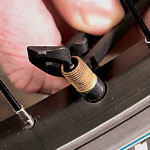 Step 4. Completely deflate the tire. It’s much easier to get the tire off of the rim and the tube out of the tire if there’s no air in it. We used the pointed end of a tire lever to release the air, but a fingernail can also depress the valve core.
Step 4. Completely deflate the tire. It’s much easier to get the tire off of the rim and the tube out of the tire if there’s no air in it. We used the pointed end of a tire lever to release the air, but a fingernail can also depress the valve core.
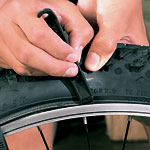
 Step 5. Use the flat ends of the tire levers to create some space between the tire and the rim. Use three levers, placed two spokes apart, with the flat end underneath the edge of the tire, and the pointed end attached to a spoke.
Step 5. Use the flat ends of the tire levers to create some space between the tire and the rim. Use three levers, placed two spokes apart, with the flat end underneath the edge of the tire, and the pointed end attached to a spoke.
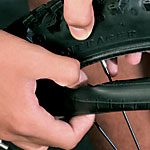 Step 6. Pry the inner tube out from between the tire and the rim. With the inner tube removed, the tire will slide off the rim easily.
Step 6. Pry the inner tube out from between the tire and the rim. With the inner tube removed, the tire will slide off the rim easily.
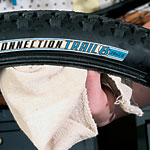 Step 7. Run a rag inside the tire around its entire length, checking for anything that could have caused the flat. It won’t do any good to patch a tube
Step 7. Run a rag inside the tire around its entire length, checking for anything that could have caused the flat. It won’t do any good to patch a tube
or install a brand-new one if the rock or shard of glass that caused the flat is still in there. The rag will protect your fingers.
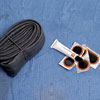 Step 8. If you’re on the road, you can repair your tube with a patching kit. This will provide enough protection to at least get you home. If you do have a new tube handy, replace the damaged one.
Step 8. If you’re on the road, you can repair your tube with a patching kit. This will provide enough protection to at least get you home. If you do have a new tube handy, replace the damaged one.
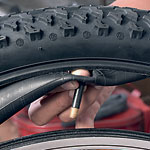 Step 9. Repeat the process in reverse order to put the tire back on the bike. (Except try not to use the tire levers, as they can pinch and damage a tube when you’re putting it back on the rim.) Align the air valve stem with the hole in the rim through which it fits. Until you get familiar with the process, never have both tires off at the same time. As long as one tire is on the bike, you can use it as a reference for how the other one should fit.
Step 9. Repeat the process in reverse order to put the tire back on the bike. (Except try not to use the tire levers, as they can pinch and damage a tube when you’re putting it back on the rim.) Align the air valve stem with the hole in the rim through which it fits. Until you get familiar with the process, never have both tires off at the same time. As long as one tire is on the bike, you can use it as a reference for how the other one should fit.
THE BRAKES
Nothing is more dangerous for a biker than having unreliable brakes. Just like monitoring your tire pressure, it’s easy to check your brakes to make sure they’ll be there when you need them.
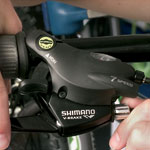 Step 1. Start by simply rolling the bike while walking alongside it. When you apply the brakes, the bike should stop immediately with no delay or drag.
Step 1. Start by simply rolling the bike while walking alongside it. When you apply the brakes, the bike should stop immediately with no delay or drag.
Step 2. Check the brake tension. Look for the brake-adjusting barrel located on the inside half of the handlebar braking device. Adjusting the barrel counterclockwise will tighten the brake cable, moving the brake pads closer to the rim. Turning the barrel clockwise will loosen the cable and create more space between the pad and the rim. Leave three to four millimeters, but this is mostly a personal preference that you can adjust to your best fit.
Step 3. You can also move the brakes to the left or the right to make sure the pads on one side don’t wear down faster than the pads on the other. There is a brake centering screw on top of each braking clamp on each wheel. Loosen the screw and move the brakes left or right as needed.
THE GEARS
Over time, the gear cable that runs from the sprockets to the gear-shifter by your hands will stretch. This can make it more difficult to shift gears. This problem can easily be fixed by adjusting the derailleur.
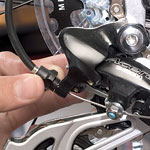 Step 1. If your gears aren’t shifting smoothly, or if they’re making noises they weren’t making before, try turning the derailleur adjustment barrel counterclockwise in 180-degree increment turns to tighten the slack in the cable.
Step 1. If your gears aren’t shifting smoothly, or if they’re making noises they weren’t making before, try turning the derailleur adjustment barrel counterclockwise in 180-degree increment turns to tighten the slack in the cable.
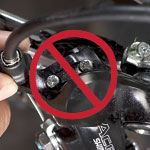 Step 2. Avoid adjusting the limit screws that keep the derailleur in place unless the bike has been damaged in a crash.
Step 2. Avoid adjusting the limit screws that keep the derailleur in place unless the bike has been damaged in a crash.
THE CHAIN
A bike’s chain is the component that makes the whole thing go. It should be clean but slightly oily. It should never be dripping with oil. Check it whenever you’re tuning up your bike.
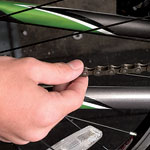
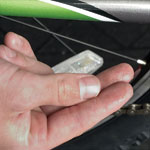 Step 1. With one hand, turn your bike’s pedals. With the other, allow the moving chain to run through your fingers. (You may have to have a friend raise the bike in the air if you don’t have a stand.)
Step 1. With one hand, turn your bike’s pedals. With the other, allow the moving chain to run through your fingers. (You may have to have a friend raise the bike in the air if you don’t have a stand.)
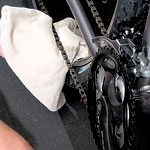 Step 2. If the chain is soaking wet, run the chain through a dry cloth to remove the excess liquid. If the chain is dry, apply a Teflon bike spray evenly over the whole chain.
Step 2. If the chain is soaking wet, run the chain through a dry cloth to remove the excess liquid. If the chain is dry, apply a Teflon bike spray evenly over the whole chain.
Step 3. It’s O.K. if the spray gets on the gears, but don’t get any excess spray on the pedals or brake pads. Hold the spray in the same spot near the back gears while rotating the pedals so the chain moves. (Spray while turning the pedals backward five times at a moderate speed.)
Step 4. After you spray, repeat the testing process to make sure you haven’t sprayed too much.
don’t listen to the guy who said not to use wd-40 its fine it just like oil only beter. oil and every thing else will clog up your gears so DO NOT USE OIL OR GREASE!!!!
WD-40 isn’t designed to be a lubricant, just a penetrant. Use a bike-specific chain oil, and not grease. Source: I ride for a mountain bike race team
if i try this i know ill end up with many pieces of bike spewed all over the place and i really will be stuck then!
When lubing the chain, spray the lube on the inside of the chain. That way, centrifugal force will push the lube into the pieces. Otherwise, the lube will just fly off the chain.
The info was helpfull… anyway it helped me since my brakes wern’t working and I was able to also replace my bike tire…
anyway I priddy much do repare bikes for a living
Thanks Heaps For The Info My Best Buddy In The World Damon Found This Info Really Useful
God Bless
p.s Biggest Bike Fan Of 2009
don’t use wd-40 on a bike chain or gears. it gunks it up. go to your local bike store and get a special chain oil. when you’ve blown a flat and you dont have a spare tube, tape over the hole will at leaset get you by for a while if you have a small pump. DO NOT BIKE WITHOUT TAPE AND A PUMP! also, if your handlebars or seat wont stay put no matter how hard you tighten the screws, use semi-permanent Thread-Lock to hold it.
I use wd 40 it works beter
It is a penetrant, not a lubricant
this is help full i ended up breaking the treads on my tire on a rock and now i know that i will not tip over on a busted tire because i know how to fix it now.
Thanks for the advice! now i’ll know how to fix my gears.
When my bike gets a flat on the back ,i thought that i had to take it to a bike shop
this is not helpful to experienced riders, most of them could do this on the go.